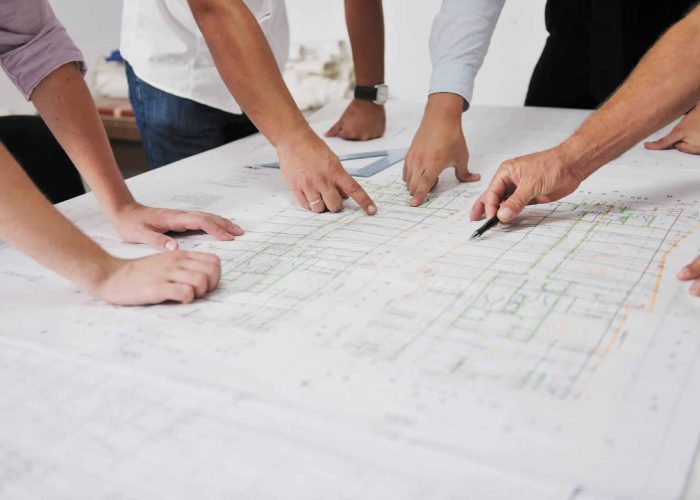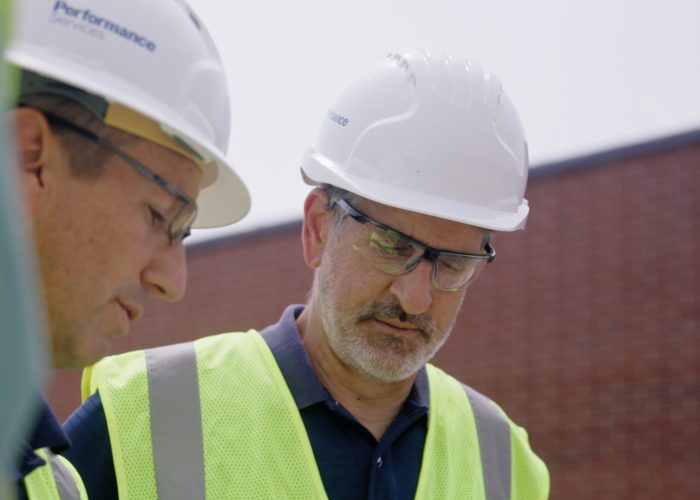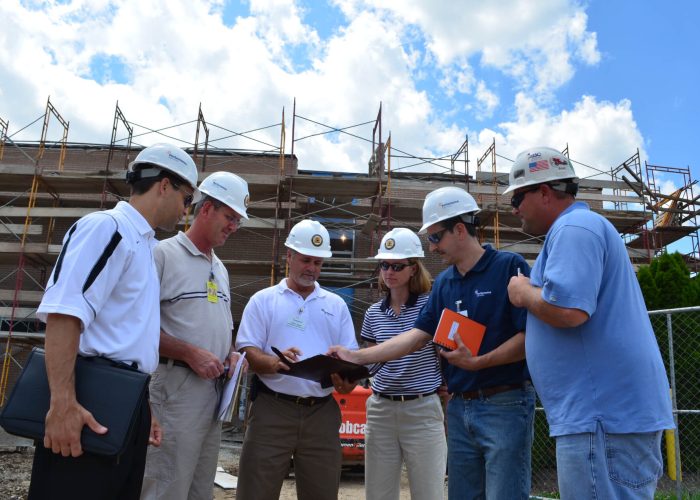Introduction
Design-build construction will represent up to 47% of non-residential construction spending by 2026. There’s a reason for that. In fact, there are ten key reasons for that. I’ll break down the top ten reasons public owners are switching to design-build for their new construction and renovation projects.
Design-Led, Design-Build: Why It’s A Better Way to Build
Design-build construction is a project delivery method where a single entity, the design-builder, is responsible for both the design and construction phases of a project. In a traditional construction approach, like design-bid-build, the design and construction phases are separate, with an architect or designer creating the plans and the contractors bidding on and building the project based on those plans. As a result, there is often finger-pointing and headaches from managing separate contracts. In contrast, design-build streamlines the process by integrating the design and construction under one roof and provides single source responsibility by having one contract with one firm. Unlike many design-builders today, our process is led by architects and engineers, not construction management. We utilize a design-to-budget approach to best meet owner objectives.
Related Reading: What’s the Difference Between Design-Bid-Build and Design-Build Projects?
10 Reasons to Choose Design-Build for Your Next Construction/Renovation Project
Design-build is growing in popularity across the U.S. for public owners as the process produces more efficient, cost-effective results. Below are the top ten reasons for that growth. First, a quick overview before we dive deeper:
- Teamwork: The Ultimate Design-Build Advantage
- Total Accountability: The Power of Single-Source Responsibility
- Continuity: One Provider from Start to Finish
- Expertise: Integrated Design Teams with Proven Experience
- Professional Guides: Partners as Trusted Advisors
- Owner Control: Empowering the Project’s Success
- Collaboration: True Partnership Approach Between the Design-builder and Owner
- Open, Honest, and Frequent Communication: The Backbone of Project Transparency
- Time Savings: The Efficiency of Design-Build vs. Design-Bid-Build
- Cost Savings: Cost-Efficiency without Sacrifices
1. Teamwork: The Ultimate Design-Build Advantage
Design-build construction, the master builder approach, fosters a team-oriented mindset. Because the designers and constructors are on the same ‘team,’ everyone is working toward a common goal: A project delivered on time and on budget that exceeds the owner’s expectations. The design-builders’ team is established on day one, at the beginning of the design process. This encourages early collaboration between architects, engineers, and construction management to collaborate through the pre-construction phase to ensure the project fits within the budget without compromising quality or design.
When projects encounter challenges (and there are always challenges), pointing fingers is not an option. Instead, the design-build team is solely accountable for enacting a solution. If challenges occur with the design, budget, or construction, everyone rolls up their sleeves and works on solutions together as a team.
Why does this matter? A teamwork approach provides a seamless experience for the public owner. They don’t have to manage separate contracts, and they don’t have to act as an intermediary between design and construction entities if problems arise.
2. Total Accountability: The Power of Single-Source Responsibility
The design-build firm is accountable for the entire project, including the quality of the design, how the result looks, the total costs, and how quickly construction is completed. When the same group that designs the project also builds the project, much more attention is given to the details, including designing to the target budget, frequent estimate updates, and design constructability reviews. The costs of all aspects of the project are considered early in the process: all design fees, anticipated construction costs, and market condition forecasts. The design-builder will update the cost estimate in real-time as the design updates. This allows frequent evaluation by the owner to pursue additional scope or rethink a current situation. All this data is transparently shared with the owner by the design-builder at all steps.
Unfortunately, it is not unusual to hear about situations with design-bid-build or construction-manager-at-risk where the project cost is much more than the designer said it would be because the construction manager was not involved during the design. This often results in missing the target budget. This can cause intense stress during the projects, resulting in a financial burden or delayed schedule per needed re-designing. Such a scenario is unacceptable in the design-build world. Design-build focuses on results and owner satisfaction.
| Performance Measure | Design-Build vs. CMR | Design-Build vs. Design-Bid-Build |
| Cost Growth | 2.4% less | 3.8% less |
| Schedule Growth | 3.9% less | 1.7% less |
| Construction Speed | 13% faster | 36% faster |
*Source: Design-Build Data Sourcebook, 2021
Why does this matter? The design-builder is fully responsible for delivering on all aspects of a project, including identifying problems or issues, pinpointing the underlying causes, and correcting them. They are also responsible for managing all contracts with other companies, including subcontractors, material providers, and equipment vendors, relieving the responsibility from the owner.
Related Reading: How Does Construction Manager At-Risk Differ from Design-Build?
3. Continuity: One Provider from Start to Finish
A design-builder is involved in the project from the initial concept to construction completion. This adds an inherent efficiency to the process. Clear and effective communication channels are established before early concepts are created. This allows a streamlined process throughout design and construction. Design-build best practices utilize an integrated project leader who is an architect and leads the design team during design and carries forward as the point person during construction. This integrated project leader sees the project from cradle to grave and becomes the glue that holds the team together, as well as reliable communication with the owner.
Why does this matter? Having one team from start to finish, instead of handing off the design to another construction entity, ensures clear communication throughout the project. One integrated project leader managing the design and construction of the project creates efficiency and makes it easier for the Owner as they have one person to work with throughout the process.
4. Expertise: Integrated Design Teams with Proven Experience
There is a tremendous advantage to working with a design-build firm with an established in-house team and proven design-build partners. This allows your design-builder to be able to think both like a designer and a builder. Design-build team leaders are licensed professionals with advanced formal training and applicable project experience. They deeply understand the construction process, and their project experience means they’ve likely encountered and resolved various challenges. This expertise can lead to more effective problem-solving and better decision-making throughout the project. Further, an experienced design-build team is an expert in general construction and building systems and has strong partnerships with reliable and pre-qualified subcontractors.
Why does it matter? A qualified design-builder brings a wealth of design and construction experience to the table and helps guide the Owner through the process. Their intimate knowledge is critical at key checkpoints during the design phase as they understand how early design decisions can impact the budget or construction.
5. Professional Guides: Partners as Trusted Advisors
There are stories of design and construction projects getting out of hand. However, design and construction should not be chaotic or stressful. The design-builder is a trusted advisor to the owner throughout the design and construction process, guiding the way to the best possible outcome. Design-build provides a best-practice process from beginning to end.
Why does it matter? The design-builder takes full responsibility for the project, and they want to see it executed as well as the Owner does. They have ‘skin in the game’ too.
6. Owner Control: Empowering the Project’s Success
Design-build allows the owner to participate in designing and building their project actively. As a result, the owner is assured their project goals will be accomplished by contributing to the process. Such involvement gives the owner lasting pride in their project and ensures their needs are met.
Additionally, unlike design-bid-build, the design-build process empowers the owner to select pre-qualified design consultants and subcontractors based on best value. This avoids the all-too-common circumstances of ‘being stuck with the low bidder’ who is underperforming or may not have the owner’s best interest in mind. All bids and pricing are transparent to the owner; therefore, the owner is informed about costs and alternatives. A qualified design-builder anticipates all potential hidden costs to provide the agreed-upon design within the target budget.
Why does it matter? Emphasizing owner engagement and input throughout the process ensures the project outcome meets expectations. It also ensures the Owner’s voice is heard during important planning, design, and contractor decisions.
7. Collaboration: True Partnership Approach Between the Design-builder and Owner
Unlike projects that are delivered using the construction-manager-at-risk model, where the designers and contractors have separate contracts with the owner and have no accountability to each other, design-build removes all finger-pointing. The design-builder has a master agreement with the owner. This allows the owner to retain total control over the project, and the team is there to empower and collaborate from the initial concept to completion. This creates a win-win and produces a genuinely collaborative environment.
Why does it matter? Collaboration is key to a successful major construction or renovation project.
8. Open, Honest, and Frequent Communication: The Backbone of Project Transparency
With design-build, all pricing is completely transparent. This lets the owner make educated, real-time decisions throughout the design and construction. Other delivery methods often hide costs or wait until an issue arises before budget concerns occur. Design-build creates transparent communication environments, not because people say what everyone wants to hear, but because they say what everyone needs to hear. Clear communication defines The budget early on, which drives key decisions and agreements for the entire project.
Why does it matter? This transparency provides trust between the owner and the design-builder. But most importantly, it allows projects to stay on or under budget without change order delays and cost overruns.
9. Time Savings: The Efficiency of Design-Build vs. Design-Bid-Build
Maintaining or exceeding the planning, design, and construction schedule is paramount for a successful project. Design-build construction involves managing hundreds of timelines that must be coordinated in lockstep. Design-build creates opportunities for the owner to contemplate major decisions, ask questions, get real-time feedback, and make proactive decisions that can impact schedule goals. All key stakeholders are at the table from the beginning of the process. Anything the team can do to avoid taking steps backward will lead to better, faster, and more cost-effective results. The design-build system is highly adaptive and responsive during construction. Big decisions can be revisited throughout without the added cost and time delays created by change orders due to design oversight or gaps in plans and specifications, often seen in design-bid-build and construction manager-at-risk delivery models.
Why does it matter? Some components of construction may not be dependent on the completion of the design and can happen parallel to design work. Any issues between design and construction can be identified early on, and changes can be made collaboratively throughout the process.
10. Cost Savings: Cost-Efficiency without Sacrifices
Inherent to the design-build model is a design-to-budget approach that identifies essential design elements up front rather than reacting downstream and cutting costs from an over-budget design. These project cost savings have been well studied and documented, as noted in the DBIA table above. Along with inherent cost savings, the project is completed faster because of the ability of parallel schedules and no change orders in the agreed-upon scope of work. Even when scope changes are inevitability made along the way, the single and integrated team is naturally in a better position to respond quickly and efficiently.
Why does it matter? Owners can rest assured knowing their projects will be completed on time, but most importantly, on budget.
Case Study: Wisconsin Heights School District
The Wisconsin Heights School District has used the traditional design-bid-build model for completing construction and renovation projects for many years. They experienced the tension of managing separate contracts with separate entities, including finger-pointing and unpleasant and surprising change orders. As a result of their experiences, the District sought a better way to renovate its campus, ensuring a more collaborative and cost-effective process. When the time came for their next construction project, resulting from a successful referendum, the District investigated the design-build approach and learned it could better meet their needs.
In 2020, the District ultimately chose Performance Services as its design-build partner to create a one-campus district by renovating the Middle/High School building and expanding it to accommodate elementary students. District Administrator Jordan Sinz said, “The most significant consideration in our selection decision was a single point of contact with one contract. The board and I did not want any buck-passing or finger-pointing. With design-build, the buck started and ended with the design-builder. Time was critical for our situation, so this delivery method with sole accountability for design and construction was right for this project.”
Despite several challenges, including the COVID-19 pandemic, the project was completed on time. Despite ever-changing restrictions, associated cost escalations, and related supply chain delays, Performance Services worked with the District to ensure the designs and materials did not exceed the project costs. The Design-Build team constantly communicated with the District through every challenge to provide the best possible outcome. Ultimately, the project was delivered as promised, on time, and with no change orders based on the agreed scope of work, final bids, and pricing.
Read more about the Wisconsin Heights Design-Build Project
Additional Design-Build Project Success Stories
Wisconsin Heights isn’t the only public owner shifting to design-build construction. Below are some recent success stories from our clients.
- City of Rushville: This $4.5 million adaptive reuse project transformed a century-old historic building into a new City Center. After trying and failing to complete the project on time and budget with traditional design-bid-build delivery, the City selected design-build to ensure the project could meet their goals.
- Avon Community Schools: This $113 million project is focused on renovating and expanding the District’s High School to accommodate growing enrollment. Given the complex nature of the renovations and the time to complete them, the District selected design-build to ensure the project met its timeline.
- Elkhart County Courts: This $96.5 million project has been decades in the making. After researching construction methods, the County selected design-build to design and construct a new consolidated court campus to provide a central location for residents and government officials.
- Mooresville Schools Pioneer Pavilion: After several successful design-build projects, the District chose this method. This $15.2 million project centered on creating a state-of-the-art athletic complex and expansion of the existing cafeteria.
Conclusion
The design-build method is a highly effective approach for new construction and renovation projects, providing many advantages that can’t be overlooked. From its streamlined design and construction and single-point responsibility to fostering collaboration and client involvement, this method offers a winning combination that leads to successful outcomes. The ten compelling reasons discussed above bust common myths and highlight how design-build saves time and money and ensures high-quality results and client satisfaction. By embracing these principles, stakeholders can look forward to smoother, more efficient projects, delivering on their visions and the promise of innovation, adaptability, and excellence in construction and renovation endeavors.
Ready to start building with us? Contact us today, and our talent team will meet with you to discuss how our design-led, design-build approach can take your next construction or renovation project to the next level.
Hear From Satisfied Clients.








